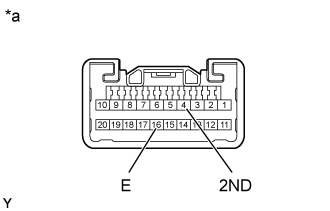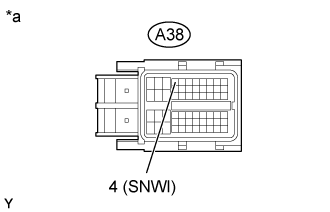Automatic Transmission System (For 3Ur-Fe) Pattern Select Switch 2Nd Start Mode Circuit
Drivetrain. Land Cruiser. Urj200, 202 Grj200 Vdj200
DESCRIPTION
WIRING DIAGRAM
INSPECTION PROCEDURE
DRIVING TEST
INSPECT PATTERN SELECT (2ND) SWITCH
CHECK HARNESS AND CONNECTOR (PATTERN SELECT (2ND) SWITCH - BODY GROUND)
CHECK HARNESS AND CONNECTOR (PATTERN SELECT (2ND) SWITCH - ECM)
AUTOMATIC TRANSMISSION SYSTEM (for 3UR-FE) - Pattern Select Switch 2nd Start Mode Circuit |
DESCRIPTION
When 2nd mode is selected with the pattern select (2nd) switch, the ECM controls the shift solenoid valves and the transmission starts from 2nd gear.The 2nd mode is the system that operates the throttle motor to control engine output to reduce skidding of the driving wheels, and guarantee takeoff acceleration, driving straightness and turning stability.When the shift lever is in D, the transmission automatically shifts up through 3rd to 6th as usual.
WIRING DIAGRAM
Refer to Pattern Select Switch Power Mode Circuit (Click here).
INSPECTION PROCEDURE
When the pattern select (2nd) switch is pushed, switch contact is made and 2nd mode is selected. To cancel 2nd mode, push the pattern select (2nd) switch once again.- HINT:
- 2nd mode is automatically canceled when the engine switch is turned off.
- HINT:
- The driving test should be performed on a paved road (nonskid road).
Start the engine.
Turn the 2nd switch off (normal drive mode).
Confirm vehicle response by driving from a parked position to fully depressing the accelerator pedal.
Turn the 2nd switch on and perform the same check as above.
When driving the vehicle with the 2nd switch on and off, check that there is a difference in acceleration.
- OK:
- There is a difference in acceleration.
| OK |
|
|
|
| PROCEED TO NEXT SUSPECTED AREA SHOWN IN PROBLEM SYMPTOMS TABLE (Click here) |
|
| 2.INSPECT PATTERN SELECT (2ND) SWITCH |
Remove the suspension control switch (Click here).
Measure the resistance according to the value(s) in the table below.
- Standard Resistance:
Tester Connection
| Switch Condition
| Specified Condition
|
4 (2ND) - 16 (E)
| Pattern select (2nd) switch continuously pressed
| Below 1 Ω
|
4 (2ND) - 16 (E)
| Pattern select (2nd) switch released
| 10 kΩ or higher
|
Text in Illustration*a
| Component without harness connected
(Suspension Control Switch)
|
| | REPLACE PATTERN SELECT (2ND) SWITCH (SUSPENSION CONTROL SWITCH) (Click here) |
|
|
| 3.CHECK HARNESS AND CONNECTOR (PATTERN SELECT (2ND) SWITCH - BODY GROUND) |
Disconnect the suspension control switch connector.
Measure the resistance according to the value(s) in the table below.
- Standard Resistance:
Tester Connection
| Condition
| Specified Condition
|
V4-16 (E) - Body ground
| Always
| Below 1 Ω
|
Text in Illustration*a
| Front view of wire harness connector
(to Suspension Control Switch)
|
| | REPAIR OR REPLACE HARNESS OR CONNECTOR |
|
|
| 4.CHECK HARNESS AND CONNECTOR (PATTERN SELECT (2ND) SWITCH - ECM) |
Disconnect the ECM connector.
Measure the resistance according to the value(s) in the table below.
- Standard Resistance:
Tester Connection
| Switch Condition
| Specified Condition
|
A38-4 (SNWI) - Body ground
| Pattern select (2nd) switch continuously pressed
| Below 1 Ω
|
A38-4 (SNWI) - Body ground
| Pattern select (2nd) switch released
| 10 kΩ or higher
|
Text in Illustration*a
| Front view of wire harness connector
(to ECM)
|
| | REPAIR OR REPLACE HARNESS OR CONNECTOR |
|
|
| OK |
|
|
|
| PROCEED TO NEXT SUSPECTED AREA SHOWN IN PROBLEM SYMPTOMS TABLE (Click here) |
|


